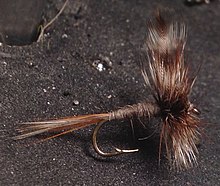
Fly fishing is an angling technique that uses a ultralight-weight lure called an artificial fly, which typically mimics small invertebrates such as flying and aquatic insects to attract and catch fish. Because the mass of the fly lure is insufficient to overcome air resistance, it cannot be launched far using conventional gears and techniques, so specialized tackles are used instead and the casting techniques are significantly different from other forms of angling. It is also very common for the angler to wear waders, carry a hand net, and stand in the water when fishing.
Mayfield is an unincorporated community in Grand Traverse County in the U.S. state of Michigan. It is located in Paradise Township between Kingsley and Traverse City along South Garfield Road. As an unincorporated community, Mayfield has no legally defined boundaries or population statistics of its own.

Fly tying is the process of producing an artificial fly used by fly fishing anglers to catch fish. Fly tying is a manual process done by a single individual using hand tools and a variety of natural and manmade materials that are attached to a hook. Although the recent history of fly tying dates from the middle 1800s, fly tyers were engaged in tying flys since at least 200 AD.
Dry fly fishing is an angling technique in which the lure is an artificial fly which floats on the surface of the water and does not sink below it. Developed originally for trout fly fishing.

The Klinkhammer, also known as Klinkhåmer or Klinkhamer is a popular parachute style emerger used in fly fishing to catch grayling and trout. It is most popular within Europe, but has a growing interest in North America.

The Pheasant Tail nymph or PT Nymph or Sawyer's Pheasant Tail is a popular all purpose nymph imitation used by fly anglers. It imitates a large variety of olive, olive-brown colored aquatic insect larvae that many fish including trout and grayling feed upon.

An artificial fly or fly lure is a type of fishing lure, usually used in the sport of fly fishing. In general, artificial flies are an imitation of aquatic insects that are natural food of the target fish species the fly fishers try to catch. Artificial flies are constructed by fly tying, in which furs, feathers, thread or any of very many other materials are tied onto a fish hook.
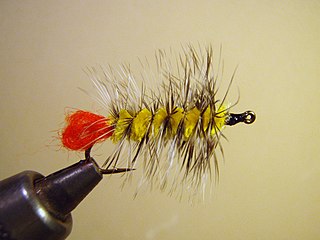
The Woolly Worm is an artificial fly commonly categorized as a wet fly or nymph and is fished under the water surface. It is a popular pattern for freshwater game fish and was a very popular fly in the 1950s–1970s in the west. Charles Brooks in Nymph Fishing for Larger Trout recommends the Woolly Worm as a general purpose nymph pattern in most western trout waters in any fly box. Woolly Worms are typically fished in streams, rivers, ponds, and lakes for trout, bass, and panfish. Today, Woolly Worms are tied in a variety of styles and colors to imitate a large aquatic nymphs such as stoneflies, dragonflies, damselflies or hellgrammites.
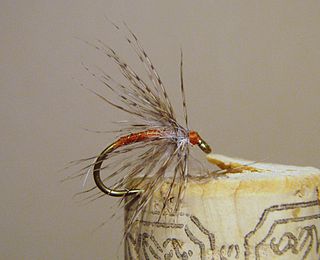
The Partridge and Orange is an artificial fly commonly categorized as a wet fly or soft hackle and is fished under the water surface. The fly is a very well known fly with its roots set firmly in English angling history. It is an impressionistic pattern fished successfully during caddis hatches and spinner falls. The Partridge and Orange is traditionally a trout and grayling pattern but may be used for other aquatic insect feeding species.

The Royal Coachman is an artificial fly that has been tied as a wet fly, dry fly and streamer pattern. Today, the Royal Coachman and its variations are tied mostly as dry flies and fished floating on the water surface. It is a popular and widely used pattern for freshwater game fish, particularly trout and grayling. Large streamer versions are also used for winter steelhead and Atlantic salmon.

This annotated bibliography is intended to list both notable and not so notable works of English language, non-fiction and fiction related to the sport of fly fishing listed by year published. Although 100% of any book listed is not necessarily devoted to fly fishing, all these titles have significant fly fishing content. Included in this bibliography is a list of fly tying, fly tackle, regional guides, memoirs, stories and fly fishing fiction related literature.

The Royal Wulff is a popular artificial fly used for dry fly fishing. It is an attractor pattern and a descendant of both the Royal Coachman fly and the Wulff style of hair wing flies named for Lee Wulff.
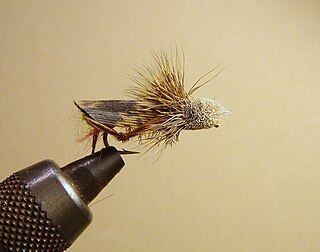
Dave's Hopper is an artificial fly used for fly fishing, designed to imitate adult grasshoppers and other Orthoptera species. It is considered a dry fly terrestrial pattern. It was designed by fly tyer and angler Dave Whitlock, and combines the best aspects of Joe's Hopper and Muddler Minnow patterns.
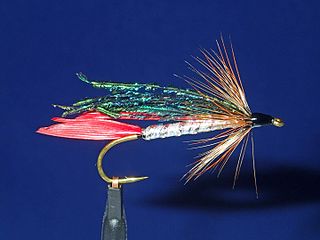
The Alexandra wet fly is an artificial fly. Also known as the Lady of the Lake, the fly was named by English angler Major William Greer Turle to honour Alexandra, Princess of Wales. The fly is distinguished by the heavy peacock herl wing and silver body which makes the fly resemble a small baitfish or fry. The Alexandra proved to be a very effective fly for trout in lakes and streams in England and Scotland in the late 19th and early 20th century. Many fly fishing purists derided the fly and its use was once banned on many English waters.

The Stimulator is a dry fly popularized by angler, fly tyer and author Randall Kaufmann to imitate large adult stoneflies.

The Sakasa Kebari or reverse-hackle fly, is an artificial fly most associated with the Japanese style of tenkara fishing but can be used in most freshwater fly fishing. The Sakasa Kebari is usually defined by firstly, its reverse hackle and secondly, by its simplicity as compared to western style flies. This fly was originally created to be used in the small, high gradient streams in Japan while fishing for native trout and char.

The Wulff series of dry flies evolved from a dry fly style conceived by angler Lee Wulff in the 1930s.

The Brown Bi-visible is an attractor style dry fly. The addition of light cream colored or white hackle at the front of the darker body made the Bi-visible easier for the angler to see on the water. Ray Bergman in his seminal 1952 work Trout gave the following credit to the Bi-visible pattern:
I gave Bivisible flies complete and indisputable credit. I believe that I even intimated they were the last word--the ultimate in dry flies. I was so sold on the Bivisibles for one complete season that if trout wouldn't take one, I figured they wouldn't take anything, and I was perfectly satisfied with this decision.

Blue-winged Olive flies is a collective term used by anglers in fly fishing to identify a broad array of mayflies having olive, olive-brown bodies and bluish wings in their adult form. Sometimes referred to as BWO , a wide array of artificial flies are tied to imitate adult, nymphal and emerging stages of the aquatic insect. While the family Baetidae probably has the most species identified as blue-winged olives, another mayfly family Ephemerellidae also contains some. Collectively, blue-winged olive mayflies are an important food source in most trout streams, thus their widespread imitation by fly tiers.

The Humpy fly is a popular and effective dry fly used by fly anglers for trout in fast-water conditions.
This page is based on this
Wikipedia article Text is available under the
CC BY-SA 4.0 license; additional terms may apply.
Images, videos and audio are available under their respective licenses.
